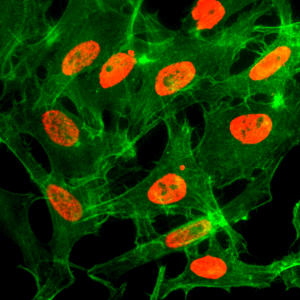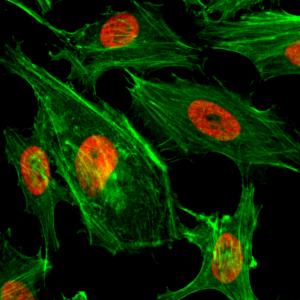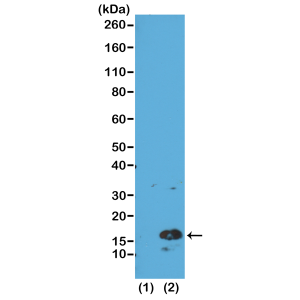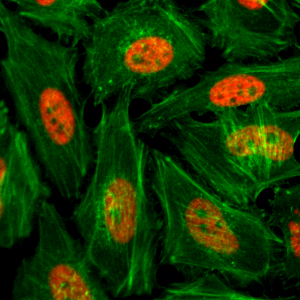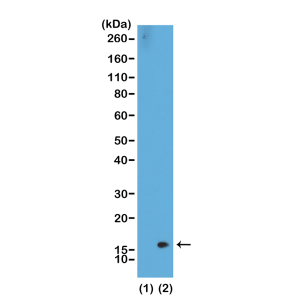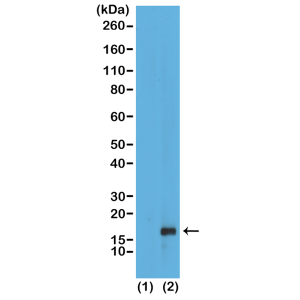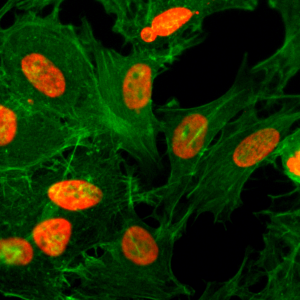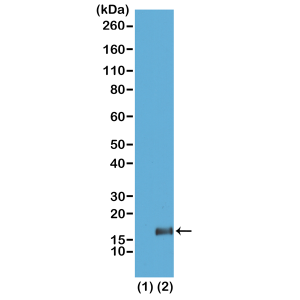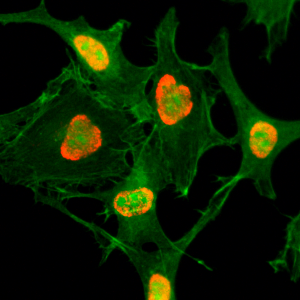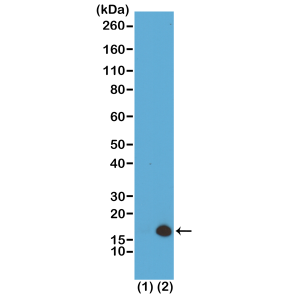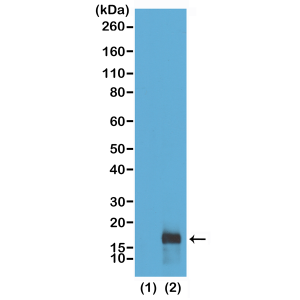
Western Blot of recombinant histone H3.3 (1) and acid extracts of HeLa cells (2), using RM181 at 0.25 ug/mL, showed a band of histone H3 dimethylated at Lysine 79 (K79me2) in HeLa cells.
anti-Dimethyl Histone H3 (Lys79), Rabbit Monoclonal (RM181)
REV-31-1065-00
ApplicationsWestern Blot, ChIP Chromatin ImmunoPrecipitation, ELISA, ImmunoHistoChemistry, Other Application
Product group Antibodies
ReactivityVertebrate
TargetH3-3A
Overview
- SupplierRevMAb Biosciences
- Product Nameanti-Dimethyl Histone H3 (Lys79), Rabbit Monoclonal (RM181)
- Delivery Days Customer10
- Antibody SpecificityThis antibody reacts to Histone H3 dimethylated at Lysine 79 (K79me2). No cross reactivity with monomethylated Lysine 79(K79me1) or trimethylated Lysine 79 (K79me3), or other methylation in histone H3.
- ApplicationsWestern Blot, ChIP Chromatin ImmunoPrecipitation, ELISA, ImmunoHistoChemistry, Other Application
- CertificationResearch Use Only
- ClonalityMonoclonal
- Clone IDRM181
- Concentration1 mg/ml
- Gene ID3020
- Target nameH3-3A
- Target descriptionH3.3 histone A
- Target synonymsH3 histone family member 3A; H3 histone, family 3A; H3.3A; H3-3B; H3F3; H3F3A; histone H3.3
- HostRabbit
- IsotypeIgG
- Protein IDP84243
- Protein NameHistone H3.3
- Scientific DescriptionHistone H3 is one of the DNA-binding proteins found in the chromatin of all eukaryotic cells. H3 along with four core histone proteins binds to DNA forming the structure of the nucleosome. Histones play a central role in transcription regulation, DNA repair, DNA replication and chromosomal stability. Histone H3 has three main variants, H3.1 and H3.2, which are deposited in chromatin only during DNA replication and H3.3, which is replication independent and is found primarily in the regions of active transcription and heterochromatin. Post translationally, histones are modified in a variety of ways to either directly change the chromatin structure or allow for the binding of specific transcription factors. The N-terminal tail of histone H3 protrudes from the globular nucleosome core and can undergo several different types of post-translational modification that influence cellular processes. These modifications include the covalent attachment of methyl or acetyl groups to lysine and arginine amino acids and the phosphorylation of serine or threonine. - Recombinant Antibody. This antibody reacts to Histone H3 dimethylated at Lysine 79 (K79me2). No cross reactivity with monomethylated Lysine 79(K79me1) or trimethylated Lysine 79 (K79me3), or other methylation in histone H3. Applications: WB, ELISA, Multiplex, CHIP, IHC. Source: Rabbit. Liquid. 50% Glycerol/PBS with 1% BSA and 0.09% sodium azide. Histone H3 is one of the DNA-binding proteins found in the chromatin of all eukaryotic cells. H3 along with four core histone proteins binds to DNA forming the structure of the nucleosome. Histones play a central role in transcription regulation, DNA repair, DNA replication and chromosomal stability. Histone H3 has three main variants, H3.1 and H3.2, which are deposited in chromatin only during DNA replication and H3.3, which is replication independent and is found primarily in the regions of active transcription and heterochromatin. Post translationally, histones are modified in a variety of ways to either directly change the chromatin structure or allow for the binding of specific transcription factors. The N-terminal tail of histone H3 protrudes from the globular nucleosome core and can undergo several different types of post-translational modification that influence cellular processes. These modifications include the covalent attachment of methyl or acetyl groups to lysine and arginine amino acids and the phosphorylation of serine or threonine.
- ReactivityVertebrate
- Storage Instruction-20°C
- UNSPSC12352203

